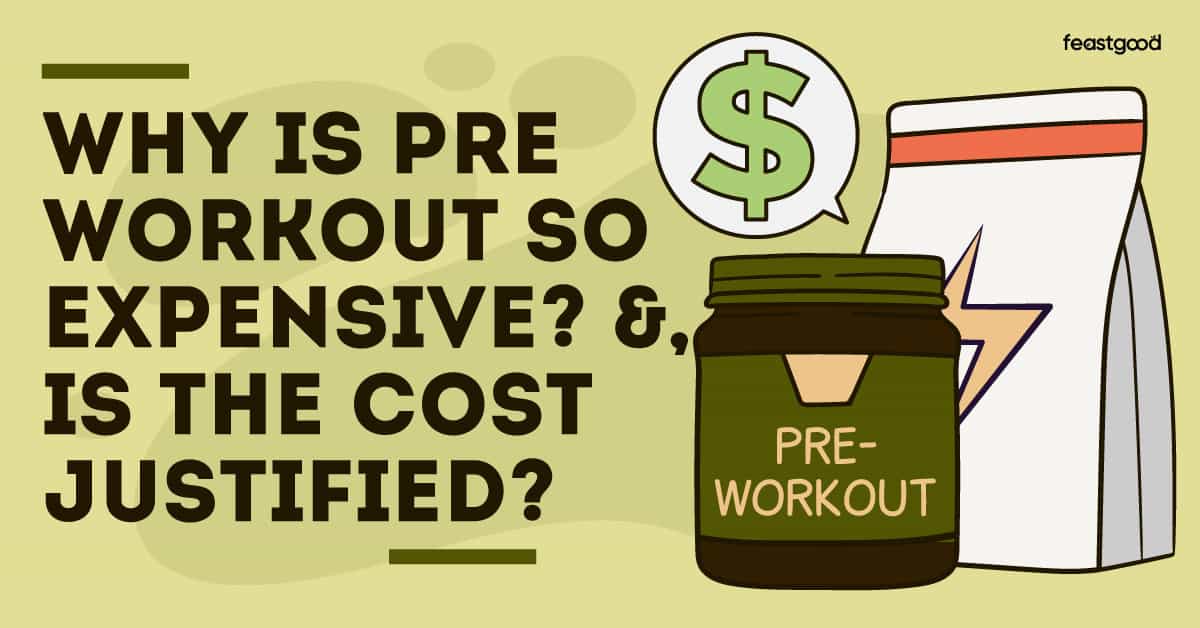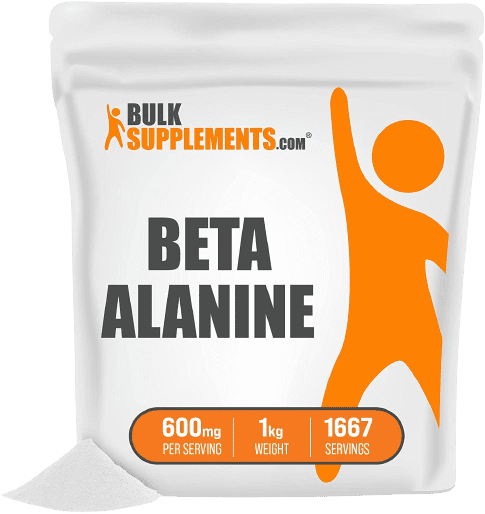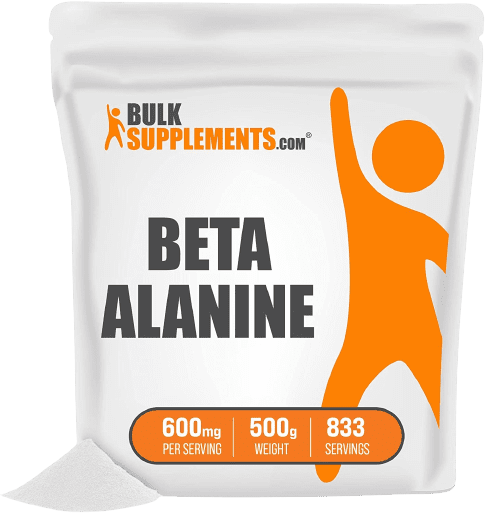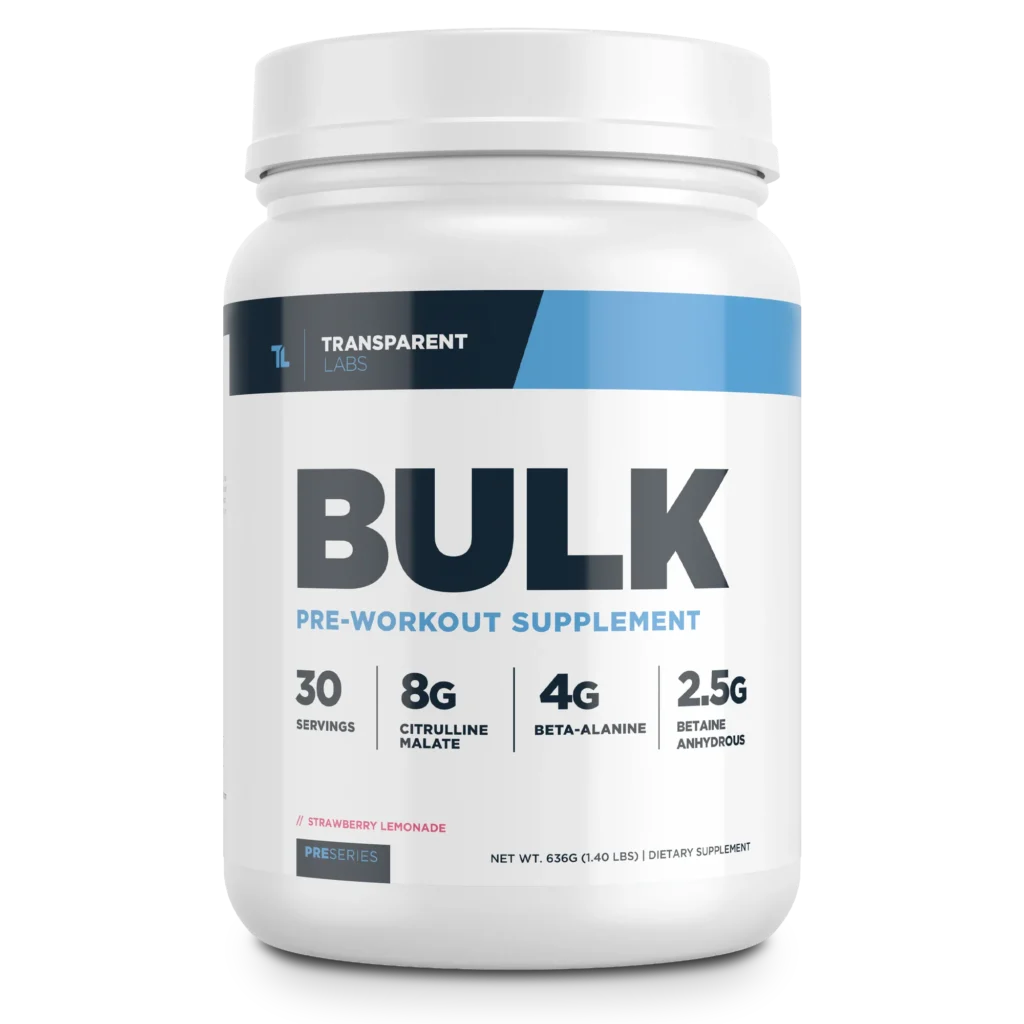Some links in this article are affiliate links, which means we earn from qualifying purchases. Learn more.
I’ve been managing a supplement store for nearly a decade, and the one category that has grown and diversified the most in my time is the pre-workout category.
In 2021, pre-workout supplements were valued at USD 15.59 Billion globally, with that number expected to jump to over USD 28 Billion by 2028.
Clearly, people are seeing value in pre-workout supplements, but at up to $3.00 per serving, you might be wondering if the cost is justified.
Yes, the cost of pre-workout is justified. Supplement companies have access to a wider variety of ingredients and have done the work of measuring them out and making them palatable. You could save money on the cost per serving by making your own pre-workout, but the process is tedious and requires more money upfront.
5 Reasons Why Pre-Workout Is Expensive
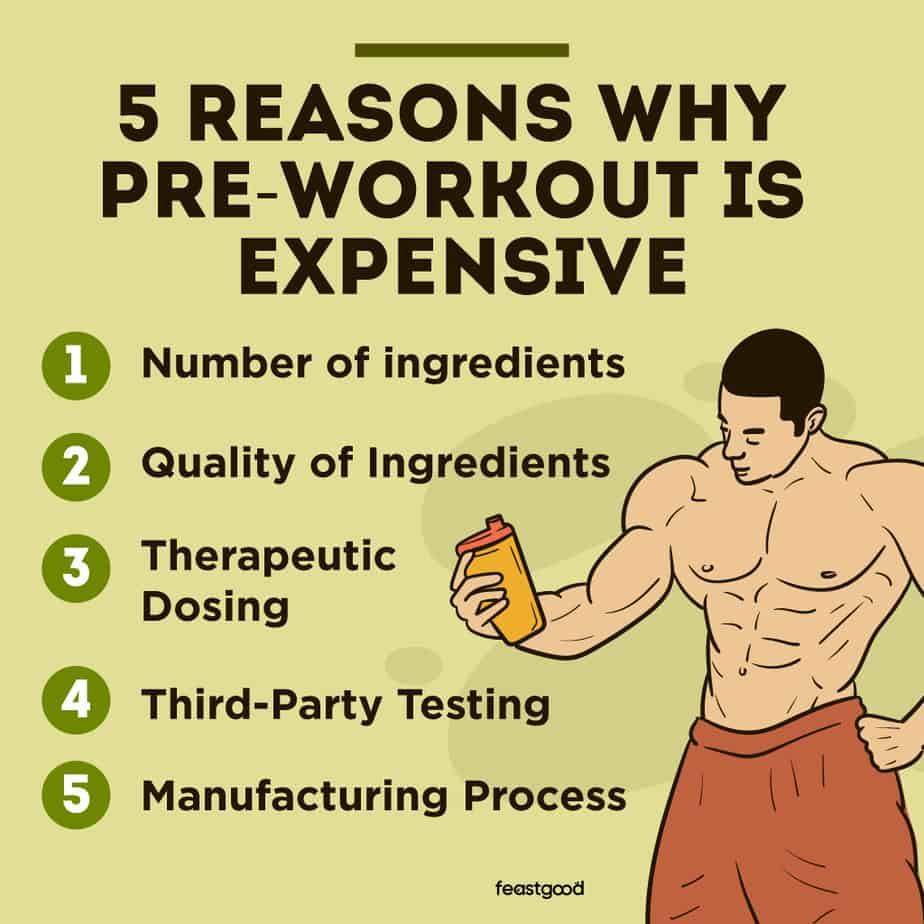
1. Number of Ingredients
Pre-workout supplements typically contain anywhere from 5 to 20 different ingredients.
This includes ingredients for
- Strength (e.g. creatine, BCAAs)
- Endurance (e.g. beta-alanine)
- Blood flow (e.g. citrulline)
- Mental focus (e.g. DMAE, theanine)
- Energy (e.g. caffeine, Peak O2)
- Power (e.g. alpha-GPC)
- Muscle building (e.g. leucine)
The end result is a single product that encompasses up to 7 different products in one.
Takeaway: More ingredients = higher costs.
2. Quality of Ingredients
Supplement companies have access to a lot more raw material suppliers than the general public does, and can afford to do extensive testing on those products.
This includes, but is not limited to, the use of patented ingredients. You can identify patented ingredients in a formula by the symbol ® beside them.
For example, Carnosyn®, is a form of beta-alanine that has been proven effective in increasing athletic performance in over 55 studies.
As a consumer, when you see a patented ingredient, you know that a lot of money has been invested into researching that ingredient and that the doses within the product match the ones that have been proven effective.
For instance, if the research indicates that 1.6-3.2g of Carnosyn® is effective, a supplement company cannot put a dose smaller than that in their product and still use the Carnosyn name.
As a result, a lot of the ingredients that they get are of the highest quality and researched at proven dosages to ensure that you reap as much benefit as possible.
Takeaway: Higher quality ingredients + patented ingredients = higher costs.
- Learn more about your optimal pre-workout dose by using our Pre-Workout Dosage Calculator
3. Therapeutic Dosing
I hinted at this one already, but therapeutic dosing means that a supplement company is using doses of ingredients that have been proven in research studies to be effective.
Consumers like yourself are reading articles like this and becoming more educated on what constitutes a quality product, and how to identify the best ones.
This has been great for the industry because it is driving supplement companies to keep improving the quality of their products.
This is not much of an issue anymore, but in past years, a supplement company would add an ingredient in a very small dose, just so that it would show up on the ingredient label and make their product look better.
For example, we know that a dose of 3.2g of beta-alanine has been shown effective in research trials. In the past, a company might put in a small dose of beta-alanine (like 1g) to make their product look better because they know that people are looking for that ingredient.
This affects the overall cost of the product today because instead of micro dosing (adding tiny amounts of ingredients), companies are adding full doses of these ingredients.
Takeaway: Higher amounts of each ingredient to maximize the effective dose = higher costs.
4. Third-Party Testing
In the past, companies have come under fire for having products whose actual ingredients didn’t match the label claims.
We’ve seen this in the form of amino acid spiking, where companies add cheaper forms of amino acids to make the protein content of their product seem higher, or companies add filler in the form of cheap sugars in place of the ingredients listed on the label.
That’s not to say a lot of companies do this, but there are some ways you can make sure that the product you’re taking actually contains the ingredients it claims to.
- Look for athlete certifications. These include BSCG (Banned Substances Control Group) and USADA (U.S. Anti-Doping Agency) certifications, the Informed Choice checkmark, NSF certification, or the USP verified logo. Any of these designations indicates that every single batch of the product undergoes rigorous testing for quality, purity, and label accuracy.
- Look for a company that specifies independent third-party testing. Some companies, like Believe Supplements, go so far as to allow you to check the tests done on the specific lot number of your product so that you can verify its quality and purity.
Takeaway: Getting third-party testing and certifications = higher costs.
5. Manufacturing Process
There are a lot of behind-the-scenes factors in the supplement industry that can contribute to the overall cost of the product.
- First is the dynamic of the retail chain where everyone along the way wants to profit.
Raw materials suppliers sell to supplement companies, who sell to distributors, who sell to supplement stores, who sell to the consumer.
Everybody along the way is out to make some money, so each time a product passes hands, the price goes up.
- Companies invest a large amount of money to get their products from the laboratory to your hands.
Companies require tubs to put the product in, labels, as well as overhead costs in the manufacturing process like wages, warehouse costs, and shipping costs.
If any aspect of this process goes up due to inflation or supply chain shortages, the cost of the product goes up as well.
We have seen this a lot since 2020. There have been both plastic shortages (meaning product is sitting in factories without tubs to be put in) and raw material shortages (like a creatine monohydrate shortage due to supply chain hold ups in Germany and China).
- Lastly, a lot of the highest quality brands have invested a lot of money into research, innovation, and securing patents.
The supplement industry is fiercely competitive, and one-way companies separate themselves from the pack is to innovate on the ingredients and blends.
Securing patents to protect these blends is a time-consuming and expensive process.
Takeaway: A complex and competitive supply chain = higher costs.
The Cost of Ingredients In Pre Workout
When it comes to the most expensive ingredients, it’s not necessarily the cost per gram that makes the product expensive, but the dosage required to create results.
For example, citrulline has a low cost per gram ($0.05), however, the minimum effective dose to get results is 6g. Therefore, per serving you’ll be spending $0.30 per workout ($0.05 per gram X 6g)
Alpha-GPC, on the other hand, has a high cost per gram ($0.22), but the effective dose required is only 250mg. This works out to approximately $0.05 per workout. ($0.22 per gram x 0.250grams)
Below are the costs of the most common ingredients you’ll find in pre workouts.
The cost is broken down into a ‘per serving’ amount, which is a product of both the cost per gram of the raw ingredient and how much you need to consume to get effective results.
- Creatine ($0.31 per serving)
- Citrulline ($0.30 per serving)
- BCAA ($0.25 per serving)
- Beta Alanine ($0.14 per serving)
- Caffeine ($0.04 per serving)
Is Pre-Workout Worth The Cost?
When it comes to convenience and ease of use, pre-workout is worth the cost. Since supplement companies can buy raw materials in massive quantities, the cost per serving is lower when compared with what you would pay if you tried to source each ingredient yourself.
Even if it is within your budget to purchase all of the ingredients on your own, it still wouldn’t be worth it to do so (in most cases).
Mixing your own pre-workout can be a tedious and time-consuming process to weigh each individual ingredient out by hand and can be dangerous if you’re not paying careful attention to which ingredient you’re dealing with.
With that said, it can be beneficial to make your own pre-workout if:
- You want to tailor it 100% to your size, needs, and preferences, and eliminate any ingredients that you don’t want or aren’t necessary.
- You have any severe dietary restrictions or allergies that could make potential in-factory cross-contamination dangerous.
Below, I’ll give you some tips on how to make your own cheap pre-workout by only focusing on a couple key ingredients.
However, in most cases, if you go down the route of making your own pre-workout, it likely won’t be any more cost-efficient than buying off the shelf from a supplement store (especially if you want all the ingredients that come in a store-bought pre workout).
5 Ways To Save Money On Your Pre Workout
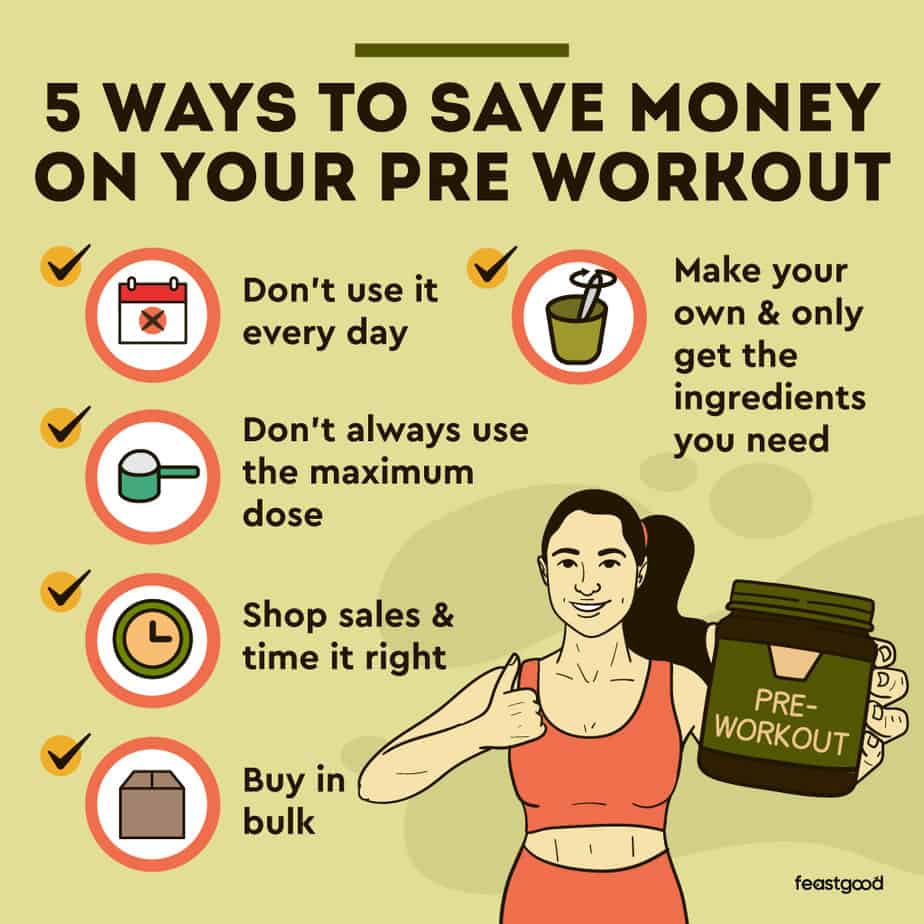
If you want to save money when buying pre-workout, here are my top 5 tips:
1. Don’t Use It Every Day
You can save money on your pre-workout by not using it every single day or for every single workout.
Especially if your product is caffeinated, if you use it too frequently you can end up building a tolerance to the caffeine and other energy/mental focus ingredients, causing the product to become less effective over time.
This works as a double-edged sword because you will require larger doses of an already expensive product, which can in turn make your product up to two times more expensive (and not to mention potentially dangerous).
Use your pre-workout only on days when it’s necessary, and choose less expensive options on other days (e.g. caffeine pill/coffee, creatine, or beta-alanine on their own).
2. Don’t Always Use the Maximum Dose
Many pre-workout labels now show two different dosage options; a lower dose for beginner to moderate users, and a higher dose for more advanced users.
Don’t always opt for the full dose of the product. Often these full doses contain between 300mg and 400mg of caffeine, which is right up against the FDA’s recommendation of 400mg daily or less.
Use the lower dose option more frequently, saving the higher dose option on days when you need it most (or don’t use the high dose option at all).
3. Shop Sales and Time It Right
Most supplement stores – both brick and mortar and online – will run regular sales. Buy during these times.
The big ones fall around Black Friday/Cyber Monday, Boxing Week, and the New Year.
But there may be lesser known ones like Customer Appreciation events and inventory clear-outs.
Find out which supplement stores are in your area and get on their VIP/e-mail lists to get notified of their sales.
Many supplement companies also offer reward programs and incentives to continue buying their products. Ghost Lifestyle, for example, has a very comprehensive rewards program that can save you money on your supplements and allows you to earn free products.
- Related Article: Ghost Legend Pre-Workout Review: Flashy, But Effective?
4. Buy in Bulk
Buying in bulk is a great way to reduce the cost per serving of your product, though this might not be feasible for everyone.
In doing the math, to replicate your favorite product and save a significant amount of money per serving you’d have to invest a lot upfront – upwards of $600+.
If you can afford this method though, you can end up paying fewer than ten cents per serving on the most popular and effective pre-workout ingredients.
If you want to go this route, find a bulk supplier (like bulksupplements.com) to place your order. I have found that they have the most consistent inventory and the greatest variety of supplements. They also offer free shipping on orders over $59, which further adds to your savings.
The next step is to choose the ingredients that you want to include in your pre workout. If you are not sure yet, try my introductory stack suggestion:
- Creatine monohydrate (5g daily, even on days you’re not training)
- Beta-Alanine (3.2g daily, even on days you’re not training)
- Citrulline (6g)
- Caffeine (100mg)
BulkSupplements.com offers a lot of size varieties to choose from. I have found the sweet spot between saving money on cost per serving and not investing thousands of dollars upfront is to buy the 5kg options (caffeine pills are bought separately on Amazon).
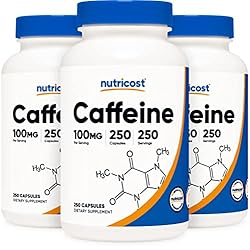
Using the above stack, here’s what your order would look like:
- Creatine – $261.96 for 1000 servings
- Beta-Alanine – $123.96 for ~1550 servings
- Citrulline – $213.96 for 833 servings
- Caffeine – $30.95 for 750 servings
Your total investment upfront for these four items would be just over $630 before tax, but the ingredients would last you almost three years, and save you a couple hundred dollars in the long run.
You might want to consider purchasing some kind of flavouring, like Mio, or mixing your ingredients with juice because the raw ingredients themselves taste absolutely terrible.
- Related Article: Can You Take Creatine Forever?
5. Make Your Own and Only Get the Ingredients You Need
You might decide that you really only need or want one or two specific ingredients, which if sourced correctly, could bring down the cost of your pre workout.
For example, caffeine and creatine for energy and strength, or citrulline and beta-alanine for pump and endurance.
In this case, spending money on a more elaborate pre-workout might not be worth it. Save money by just ordering the few key ingredients you want.
You could also consider doing a hybrid of buying in bulk, and making your own.
My recommendation here is to choose a less expensive pre-workout with only the basics, and then buy ingredients that require larger doses (like creatine or citrulline) in bulk. This way you can take a smaller serving of the pre-workout, and add the less expensive individual ingredients to get the full dose.
For example, Cellucor C4 Original is only $25 for 30 servings ($0.83/serving) but it only has 1.6g of beta-alanine and 1g of creatine. You can buy this inexpensive product, and then buy creatine and beta-alanine on their own and add 4g and 1.6g respectively to complete your product for an additional ~30 cents per scoop.
This brings the total cost per serving to around $1.13 per serving where comparable products are closer to $2.00 per serving.
Cheap Pre Workout Alternatives
If the cost of pre workout is still not within your budget, that’s okay! Here are some cheap pre workout alternatives to help you squeeze the most out of your workouts and maximize your results.
Caffeine
A simple cup of coffee or tea can provide you with the energy boost to get you started and feel good throughout your workout.
Being lower in caffeine (20mg in tea, 70mg in coffee) these alternatives will also be less likely to cause adverse side effects like jitteriness or insomnia, and a decreased risk of pre workout crash.
You can also buy caffeine tablets for absurdly cheap (around 6 cents per 200mg tablet)
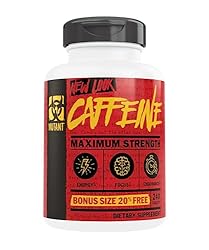
- For more ideas, check out my article: 9 Pre Workout Alternatives.
Pick one or two essentials
Two of the most popular and most researched supplements for improving athletic performance include creatine monohydrate and beta-alanine.
Creatine has been shown to improve strength, power, and muscle recovery and beta-alanine has been shown to increase endurance and work output.
- Creatine monohydrate can be purchased as an unflavoured powder for around 30 cents per 5g serving and should be taken daily over several weeks to be most effective. This puts the investment at around $2.10 per week, or $9 per month.
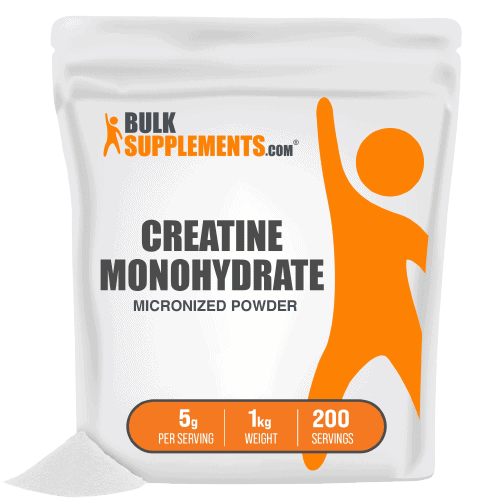
- Beta-alanine is similar, purchased as an unflavoured powder at around 12 cents for a 3.2g serving. Taken daily, this costs less than one dollar per week and around $3.60 per month.
Ultimately you could take both creatine and beta-alanine together daily for less than $15 per month and see incredible performance and recovery benefits.
- Related Article: Creatine vs Pre Workout: Are They The Same?
Proper Nutrition
Technically speaking, no ergogenic aids (i.e. supplements) need to be added to your day in order for you to see fantastic results.
An adequate pre workout meal can provide energy, endurance, and help with hydration and recovery.
Choose foods that are protein-rich (meat, eggs, greek yogurt, tofu, or protein powder) and nutritious carbohydrates like fruits and vegetables, and whole grains. These items will also be high in vitamin B12 and Magnesium which can help with energy metabolism and muscle function.
Examples of a great pre-workout meal include an egg omelet with spinach and cheese and a side of multigrain toast, or a fruit smoothie with added vegetables and a scoop of protein powder.
- Related Article: Can You Build Muscle Without Creatine?
Frequently Asked Questions:
What Is the Most Expensive Pre-Workout?
The most expensive pre-workouts found on the market include Ryse Godzilla ($2.95-$3.25/serving if you take the high dose option) and Wrecked by Huge Supplements ($2.50/serving).
- Read my complete review of Wrecked Pre-Workout
- Read my complete review of Ryse Godzilla Pre-Workout
The high cost of these pre-workouts isn’t meant to be a slight against the brands, as they have some of the highest clinical doses found on the market, justifying the cost.
What Is The Least Expensive Pre-Workout?
The least expensive pre-workouts are Six Star Nutrition Pre Workout at $0.50 per serving, Mr Hyde Signature Pre-Workout at $0.53 per serving, and Cellucor C4 Original at $0.63 per serving.
Read my complete review of these pre-workouts:
These products are underdosed on ingredients like creatine and beta-alanine (so they won’t provide the full performance benefit) but will provide a good energy boost at a cheap price.
Is Making Your Own Pre-Workout Cheaper Than Buying It?
Making your own pre-workout is cheaper (on a cost-per-serving basis) if you choose only a few key ingredients, or can afford to invest upwards of $600 to buy large quantities.
The process of measuring out your own can be time-consuming and tedious and requires careful attention to which ingredients you’re measuring.
Are More Expensive Pre-Workouts Safer?
Expensive is not always an indication of quality, and in fact more expensive ones often come with higher doses of ingredients like caffeine which could be less safe.
To find the safest ones, look for those with the “informed choice” checkmark or those that are independently third-party tested (e.g. NSF).
What To Read Next
About The Author

Jennifer Vibert is a Certified Strength and Conditioning Specialist, Nutrition Coach, and supplement store manager. She has a Bachelor of Kinesiology with a major in Fitness and Lifestyle and a minor in Psychology from the University of Regina. She is a Certified Nutrition Coach through Precision Nutrition, with a passion for helping clients learn the fundamentals of nutrition and supplementation in order to build healthy, sustainable habits.
Why Trust Our Content

On Staff at FeastGood.com, we have Registered Dietitians, coaches with PhDs in Human Nutrition, and internationally ranked athletes who contribute to our editorial process. This includes research, writing, editing, fact-checking, and product testing/reviews. At a bare minimum, all authors must be certified nutrition coaches by either the National Academy of Sports Medicine, International Sport Sciences Association, or Precision Nutrition. Learn more about our team here.
Have a Question?
If you have any questions or feedback about what you’ve read, you can reach out to us at [email protected]. We respond to every email within 1 business day.
